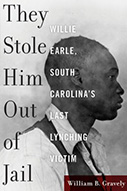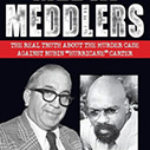They Stole Him Out Of Jail: Willie Earle, South Carolina’s Last Lynching Victim

Author: William B. Gravely
Publisher: Columbia, SC: University of South Carolina Press, 2019. 336P.
Reviewer: Nicholas W. Mason | September 2019
Historians of lynching in the United States now understand it to be more complex and important than past scholars realized. What contemporaries sometimes referred to as “frontier justice” or “extralegal violence,” lynching was a decades-, if not centuries-long, transnational system of mob violence intimately intertwined with the enforcement of white nationalism in the American South and across the country. William B. Gravely’s They Stole Him Out of Jail, forty years in the making, is one of the latest scholarly works to complicate and grow our understanding of this history of terror.
They Stole Him Out of Jail is a history of the February 17, 1947 lynching of twenty-four-year-old Willie Earle, whom the author calls the state’s “last lynching victim,” in Greenville, South Carolina. After a taxi driver named Thomas Watson Brown was attacked and later died from his injuries, local authorities arrested Earle, a black man, as a suspect. Before Earle could face trial for the alleged offense, a mob of taxi drivers seeking to avenge Brown pulled Earle out of jail, beat him, and shot him to death in retaliation. Earle’s lynching was highly sensationalized throughout the state and the subject of state and federal investigations. Although the investigations produced confessions and thirty-one suspects, an all-white jury acquitted them after a nine-day trial.
The lynching of Willie Earle is not entirely unique in its most basic details. Being accused of a crime, arrested, and then murdered by a mob before facing trial fits a pattern of American mob violence extending back to the nineteenth century. What is unique is the depth of the author’s research into the Earle case, its historical roots, and its legacies for racial violence and justice in the United States. In 230 pages, the author examines the incident itself including the killing, the investigations, the trial, the racist context of U.S. history that enabled it, the spectacle of it and contemporary reactions from many different perspectives, and its historical and collective memories as recent as the twenty-first century. Gravely draws on a variety of archival sources, as well as a rich collection of oral histories that help to highlight those voices crucial to understanding the historical legacy of the lynching.
Regarding historical context, the author argues that, after the Civil War, white South Carolinians embraced the Lost Cause narrative of the former Confederate south and formed their own identity of “Redemption from Reconstruction.” The fulfillment of that identity depended on the enforcement of white supremacy through the violent oppression of black people, the most extreme form of which was lynching. This system of violence thus continued throughout Reconstruction and the early 1900s as a way of enforcing Jim Crow and racial hierarchy, including Willie Earle’s 1947 murder.
The violent enforcement of white supremacy depended not just on the act of lynching, but also on the terror it induced. Historical memories of lynching both empowered white supremacists and terrorized black communities. This monograph acknowledges this dual power of mob violence by humanizing the victim and exploring his background and his community members’ reactions to his murder. Although “Discovering Willie Earle” is the book’s shortest chapter, it reminds historians that victims of racial violence are more than just statistics, and that their voices and agencies must be privileged when possible.
Over time, regional and national opposition to this form of murder grew. In the context of Earle’s lynching, this opposition is visible in the work of anti-lynching activists and organizations like the NAACP as well as otherwise racist politicians, such as South Carolina Governor Strom Thurmond who opposed mob violence on the basis of championing the rule of law. Yet, despite the growth of public popular reactions against Earle’s lynching, opposition voices emerged that supported it and raised money for the mob’s legal defense. Chapter three pays important attention to both sides through carefully selected accounts that both highlight the voices who spoke out against mob violence, and show the reader how persistent racism and regional culture enabled the lynching to occur.
After detailing Earle’s lynching, the first half of the book reconstructs the investigations in extended detail. The author draws upon newspaper accounts and contemporary correspondence to uncover the circumstances of the incident and its aftermath with remarkable depth. The author notes that all of the “official players” of the case, including members of the grand jury and the eventual trial jury, were white men. Likewise, regional history and legacies of impunity for lynchings challenged the prosecution from the beginning.
Chapter five probes more deeply into Willie Earle’s life and community. Because of segregation, few white Americans knew about the African American press, which covered Earle’s funeral and provided gruesome details of his mutilated corpse. The image of Earle’s body in the Associated Press prompted contemporary comparisons to Fascism and Nazi Germany from anti-lynching voices. In one of the book’s most notable interventions into the historical narrative, the author uses oral histories recorded in the 1980s and 1990s to reveal the extent of Earle’s disability, further complicating our understanding of contemporary mob violence.
Chapters six through eight detail press attention to the case, jury selection, and trial proceedings. The author pays particular attention to the court journalist, the famous English novelist Rebecca West, whose illuminating accounts of the trial reveal the diversity of contemporary reactions to mob violence. Taking account of West being something of an outsider to South Carolinians’ local culture and memory as it related to Earle’s lynching, the book covers her reactions at length and juxtaposes them against those of others in the court to highlight different perspectives and the trial’s complex and weighty legacy. The mob’s defense effectively put Earle himself on trial, as much as were his killers, and as “absurd in retrospect” as the author acknowledges, proof of his guilt came from those who murdered him.
Chapters nine and ten explore the aftermath of the trial. After the all-white jury acquitted the lynching’s perpetrators, popular reactions to the trial represented galvanized opposition to lynching and growing anti-lynching sentiment nationally, though efforts to produce federal anti-lynching legislation failed. Chapter eleven focuses on the historical memory of the lynching up to the turn of the twenty-first century. The author shows how the “symbolic power” of lynching remained long after its practice ended.
The author’s narrative is informed by relevant and appropriately selected scholarly literature, and its primary source use is strong. The author cites an enormous number of newspaper articles to reconstruct the history. The author’s uses of personal correspondence, trial documents including West’s recordings, and oral histories are likewise all convincing, and effectively supplement the narrative.
U.S. historians, and lynching specialists in particular, will benefit from the author’s depth of research and attention to detail. Well-researched and written, the author’s work incorporates many recent trends in mob violence historiography into a concise narrative of one case that also draws apt conclusions about a broader history. In doing so, the author also introduces themes that suggest avenues for future research, including historical memory, oral history, and the intersection of race and disability with violence. Non-specialists and general audiences will undoubtedly benefit from the book’s use of sources and narrative methods, as well as its larger lessons about one of the grimmest chapters of U.S. History.
The author concludes with powerful and appropriate comparisons to the present day. The legacies of lynching continue with modern capital punishment, grounded in the presumption that taking one life brings justice for another lost life. The “toxic legacy of white American racism” likewise takes the form of present-day hate crimes, of which the author cites the tragic Charleston Church Shooting of 2015 as an example. Connected all but seamlessly to the present day, They Stole Him Out of Jail reminds readers that the history of lynching and racial violence in the United States is not a closed book, but an ever-relevant story, and that the historian’s job is to continually engage with these legacies as they continue to be relevant.
Nicholas W. Mason, Graduate Student and Teaching Assistant, Department of History, Maxwell School of Citizenship and Public Affairs, Syracuse University


